A Summer Picnic for Pollinators
There was a lot of buzzing in the garden the other day, buzzing and fluttering. So I decided I would do a little pollinator post. Judy was out of town, though, so these pics are not be up to her usual quality.
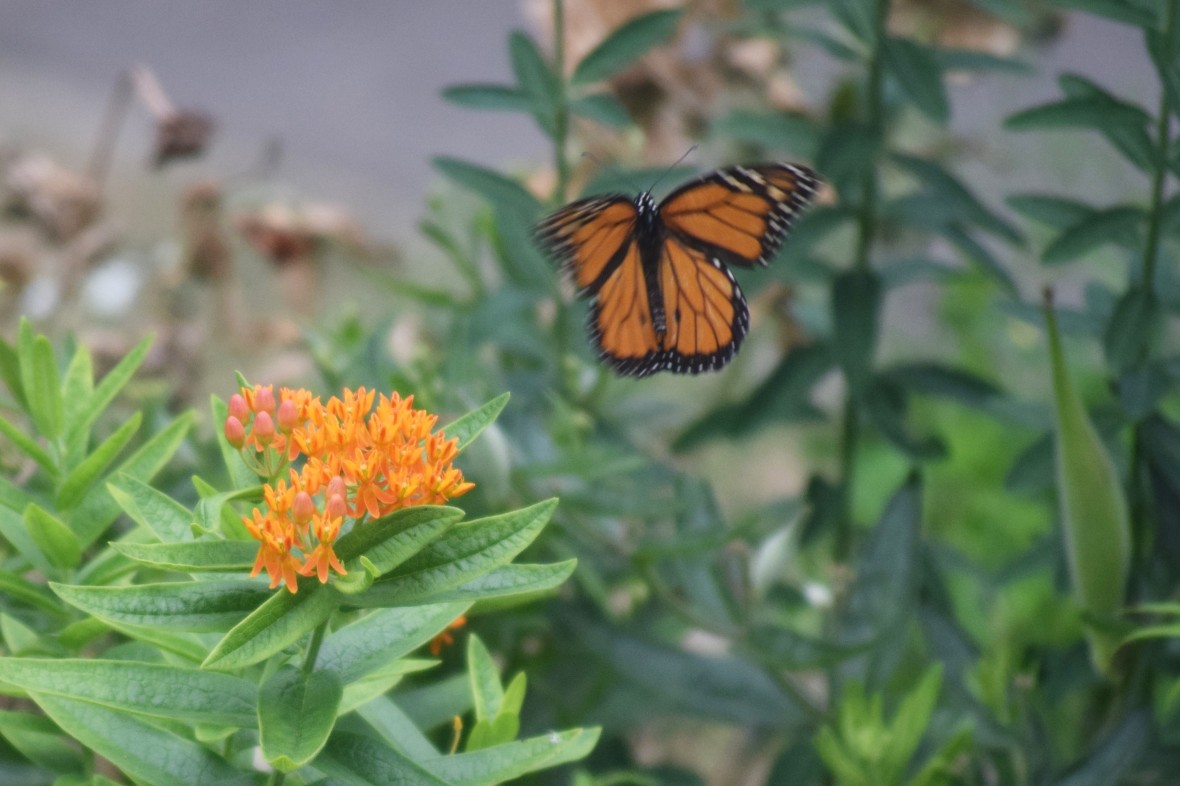
I can’t resist starting with the Monarch Butterflies. These days there are usually three Monarchs in the front garden. That number often grows as we move further into late summer.
Sometimes two but at other times all three Monarchs will chase each other around the garden. This is a mating behavior, I think. I certainly hope so, because we haven’t seen any caterpillars in weeks.

Here’s something I learned recently. When Monarchs first come out of the chrysalis, their proboscis is divided lengthwise into two halves. The halves have to combine before the Monarch can feed. Isn’t that weird?

This male isn’t looking too fresh. I wonder if there is some kind of Grecian Formula for male Monarchs who want more youthful-looking wings.

Along with the Monarch threesome, there is usually a Black Swallowtail out front. It’s sort of hyperactive, and so difficult to photograph. Sometimes it joins in with the Monarchs when they chase each other around. Other Butterflies I saw but did not photograph include a Cloudless Sulphur and some Red Admirals.
And there were plenty of Cabbage Whites, of course. Would we find Cabbage Whites more interesting if they had a better common name? How about like Crucifer Ecru?
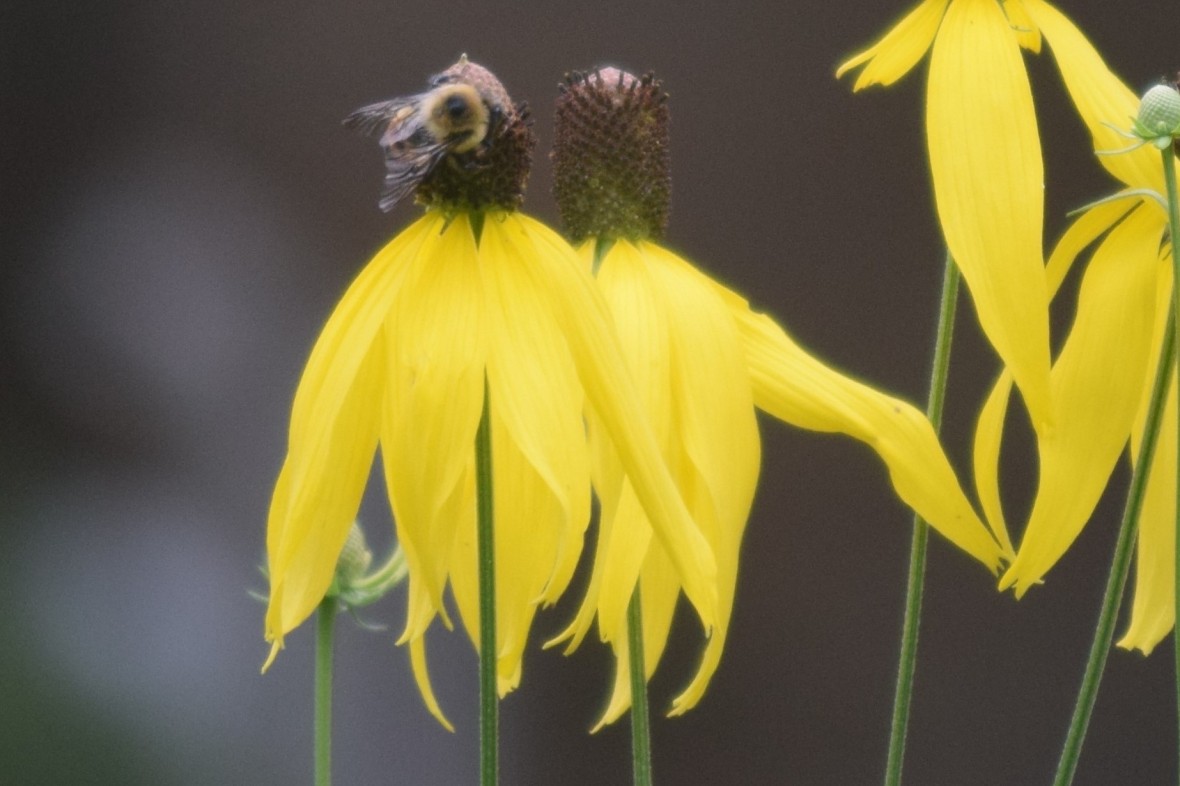
There are lots of Honeybees and Bumblebees around on any given day in the front garden. For now, though, let’s give some attention to the less cuddly pollinators.
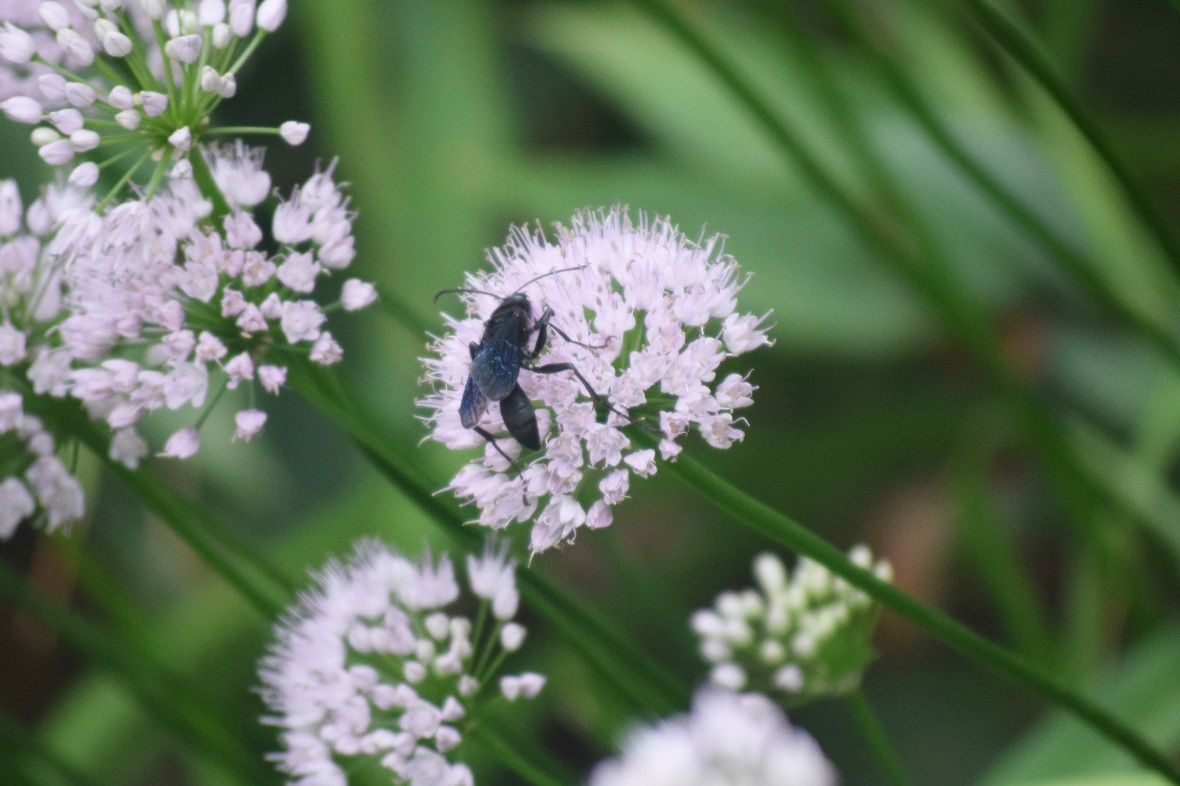
I think this is a Digger Wasp, but please feel to correct me if I’m wrong. Digger Wasps are big and look dang scary, but they are unlikely to sting people.
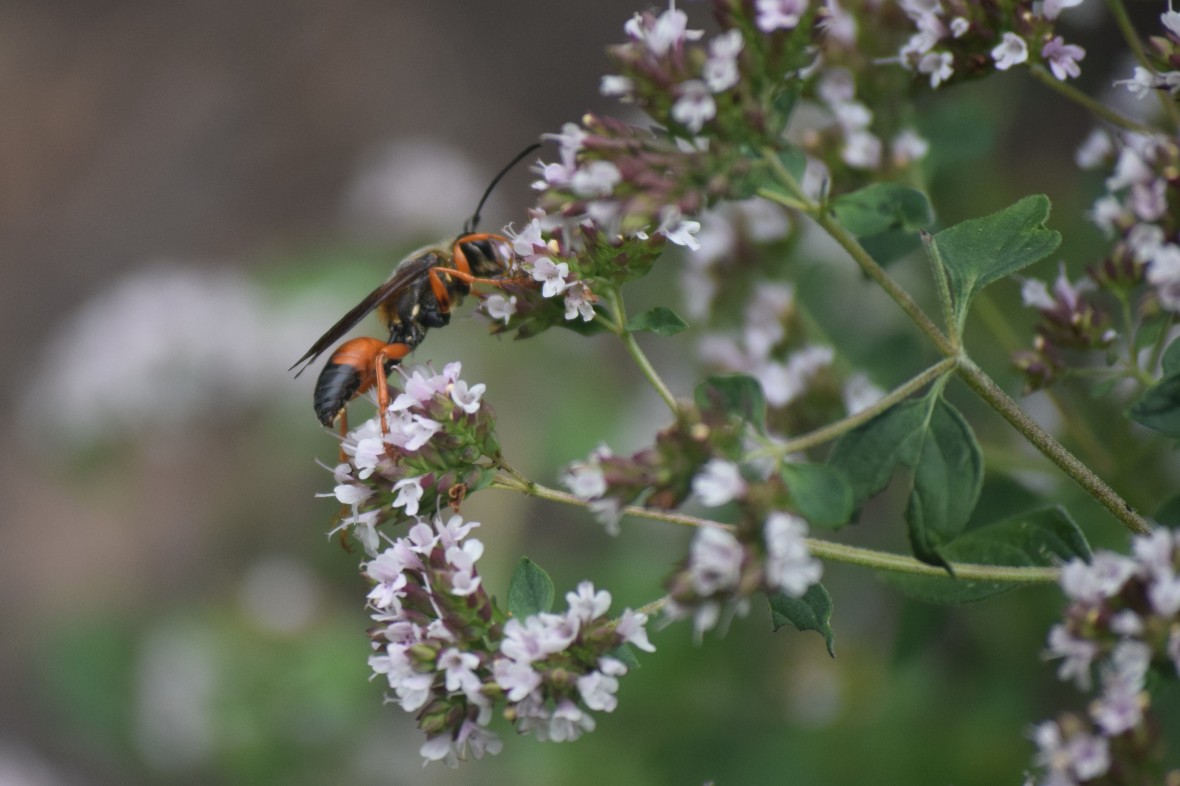
Pretty sure this is another Digger Wasp on some Ornamental Oregano (Origanum laevigatum).

Is that a bee or some kind of bee-mimicking fly on the Allium lusitanicum ‘Summer Beauty’? Either way, it’s about to be joined by a Bumblebee.

Fly, I think, because there’s only one pair of wings and short antennae. Don’t look down on flies. While some are annoying, others are important pollinators.
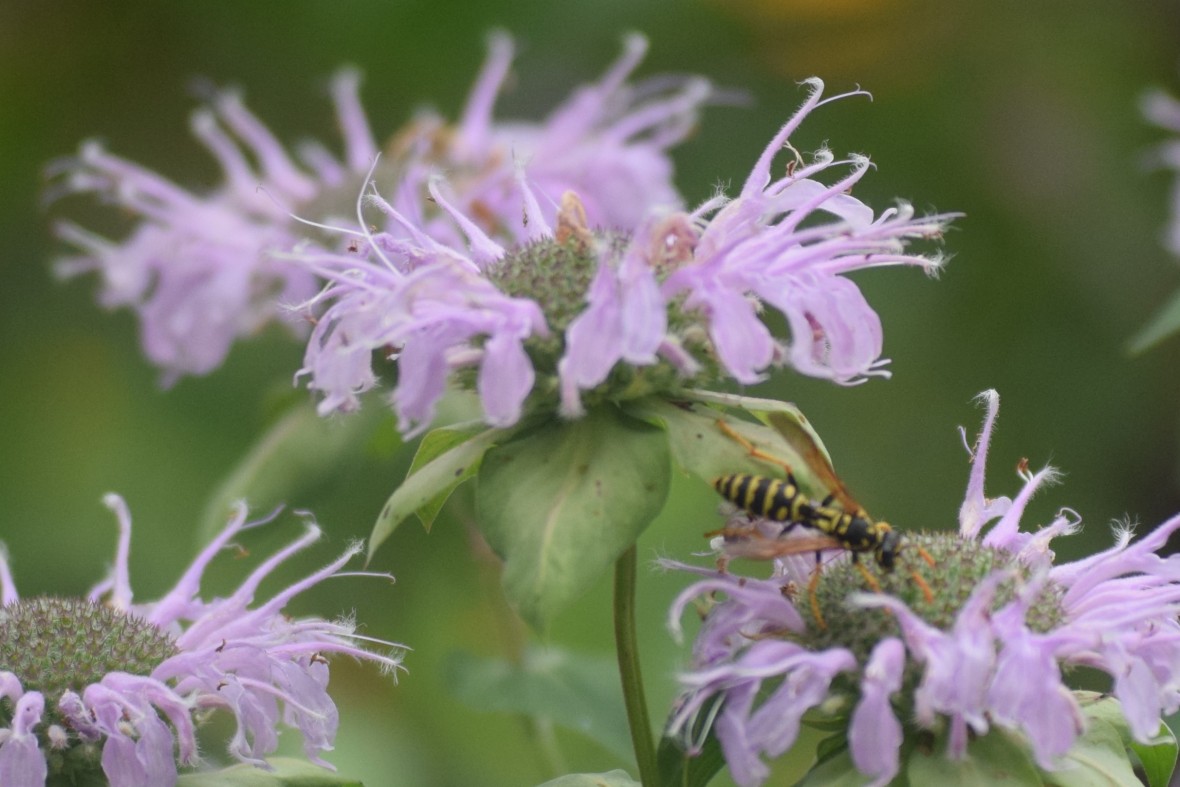
Who is this on the Wild Bergamont (Monarda fistulosa)? Maybe a Sweat Bee?
That’s all for now. I hope to continue capturing on film some of the less obvious pollinators. It can be a challenge, especially for the really little ones. A goal for retirement, I think, will be to develop a deeper knowledge of the pollinators in the garden.
Are you seeing plenty of pollinators around your garden?





Wonderful photos, Jason!
Thanks, Nadezda!
First, Judy has apparently been schooling you well because these photos are very good. 🙂 Your garden does look like a way station for these beauties. We see a fair amount of pollinators but hardly ever a Monarch so I always enjoyed seeing yours.
They’re certainly the flashiest of the butterflies we see around here.
We have lots of pollinators this year. The butterfly population is doing well.
Seems like a pretty good year for butterflies. Haven’t seen any tiger swallowtails since June, though. Otherwise, it’s been good.
Over the years, I see fewer and fewer pollinators in my yard – I suspect several of my neighbors spray theirs. As summer progresses, though, more bees and such show up. Inspecting the milkweed for eggs and caterpillars is a lesson in tiny bugs, especially spiders. I suspect they are the ones that eat the monarch eggs.
I suspect the spiders, also. It’s good to see the bees, though. Maddening when the neighbors spray. I try to discourage them without being too preachy.
I’ve had bees all summer long and Cabbage Whites. There was one yellow swallowtail last week and this morning I saw my first monarch on a zinnia.
You have a pollinator party at your house.
Maybe you’ll see lots more Monarchs as the fall migration gets underway.
Very weird. We’re seeing more butterflies than usual so far this year, but I find them a challenge to photograph. They did a great job of eating the foliage on our garden peas, but we still got a decent crop. I have heard that the dry weather might affect the food stocks later in the season for the ones still to hatch out, so it might not be good news in the longer term.
Your pictures are lovely, especially the ones with the Mexican sunflowers.
Mexican Sunflowers are my favorite annual, and they are butterfly magnets!
The pollinator-watching really is excellent right now. We’re commonly seeing swallowtails (black and tiger), monarchs and red admirals in addition to cabbage whites and clouds of bees. On Sunday morning we sat on the porch watching them literally for hours.
Watching the bees et. al. is one of the true joys of gardening. Glad that you and your family make time for this simple pleasure. Sounds like you’ve made a happy space for pollinators.
Kudos to you for choosing such gorgeous plants that the insects want and need. Those pollinators certainly add to the beauty of your garden. You can crop that last photo, highlighting the insect more and send it to bugguide.net. I’ll bet someone there can id it for you.
Good idea, thanks for the suggestion.
You did a fine job with the photos. Yes, we have plenty of pollinators in the garden. Many are slurping up the last of the clethera blooms. My clethera shrub is large enough that it sweetens the air with it’s lovely fragrance. I often stand by it mesmerized by all the pollinators. I do think I hear slurping from time to time. Naw maybe it is just wings whizzing.
I have Clethra ‘Ruby Spice’ but it’s kind of sickly, with very few flowers. I don’t think it is suited to my garden. Beautiful plant in the right space, though.
I’ve seen exactly one monarch butterfly so far, but that’s better than none.
I’m seeing lots of other butterflies like tiger swallowtails.
The tiger swallowtails are really beautiful.
I was finally able to catch a monarch in action today – it’s always exciting when I can get one on film (or should that be SD card?). A cabbage white by any other name is just as prickly as the dang rose – I’d need half the amount of netting on my beds if it wasn’t for those “rascals” 🙂
The cabbage whites don’t bother me so much since we only grow a few herbs. I still think of it as film, even though we went digital years ago.
Your pictures are fabulous, especially the ones of the monarchs. Lots fluttering and buzzing in my garden, but alas, no monarchs.
Still a wonderful thing to have bees and butterflies, even without Monarchs.
My flowering mint is straggly as all get out, but it is buzzing with tiny bees. So it stays! The bees come first.
What a wonderful array of insects, though the Digger Wasp is somewhat scary. Our blackberries might start attracting wasps and the mint is currently in flower and covered with bees. I wonder if you can get mint-flavoured honey from it?
I bet you could. The flavor of honey is definitely affected by which flowers are visited by the bees.
Bees and flies confuse me so much. Part of the problem is that by the time I get a flower identified, I’ve run out of time to spend identifying the critter. Of course, for most of my purposes, “bee” or “wasp” or “fly” will do, until I become more knowledgeable.
One I did manage to photograph and ID is a syphid fly that mimics the shape of a wasp. It looks like it’s fierce and aggressive, but it’s only looking around for a little nectar and pollen — and aphids! Here’s a pic from iNaturalist.
Make that ‘syrphid fly.’
That’s a great shot! The syrphid flies are welcome to all the aphids they can eat!
I bought a book on bees and I still have a hard time figuring them out. But it seems to be a good year for pollinators in my yard too, and since it’s too hot to go anywhere else this weekend I think you’ve inspired me to take a look at what’s going on right outside the air conditioning. 🙂
Happy hunting!
How great you are getting so many monarchs along with all the other pollinators! I didn’t know about that proboscis thing – fascinating!
Fascinating – and weird.
Lovely! We have all sorts of visitors on our Silphiums, Joe-Pye, etc. in our pocket meadow in Asheville. It’s amazing. No monarchs here at the moment.
I love the idea of a pocket meadow. I’m trying to develop a sedge meadow in a shady part of the back garden.
Hi Jason .. You caught some great pictures here .. I wish I saw more Monarchs in my garden ..but .. I haven’t been in my garden a lot, the heat is too overwhelming .. it is due for a tidy up though so I have to just brave on ? LOL
Did you find the lilies seemed to take longer to bloom this year ? .. Casa Blanca was later .. I had a hard time with lily beetles especially this year, maybe they love the heat and drought ?
I have Joe Pye and a few others ready to go full bloom soon so hopefully I can serve up some delicious dishes for these pollinators too !
The heat can make it a real challenge to keep up with the garden chores. Happily we’ve gotten through our hot spell for now and temps are much milder.
Your garden provides a lot of pleasure and sustenance for both pollinators and the human soul!
Thanks. I like to think so.
What a rewarding sight for all your gardening efforts, to have all those pollinators visiting, and with any luck, staying and breeding. And congrats on the varied biodiversity. I welcome any flies and all insects and spiders, except European wasps and common House Fly – that one deserves its name!
Yeah, I can’t say anything good about house flies.
Your photos are fab! It would have been a great year to grow Tithonia here but I didn’t. Oh well, maybe next year. Not that we get Monarchs here, of course, but all the pollinators we do have love them.
It’s my favorite annual, absolutely.
I love the way the Monarch butterflies are a perfect match for the tithonia. You have so many interesting bees and wasps that I have never seen before.
The Monarchs and Tithonias do seem to be color coordinated.
What a wonderful array of pollinators you have, I did enjoy seeing the digger wasps, how eerie looking they are. Some great pictures here, especially of the monach on the Mexican sunflower. How odd about their proboscis, I didn’t know that.xxx
The digger wasps an be intimidating but they are really pretty gentle.
Great photos – especially with the Tithonia! 🙂
Jason, I believe that last picture is of a paper wasp. Years ago I was pruning shrubs with an electric trimmer and sliced through the nest buried in the middle. Didn’t have any idea I could still run like I did in high school track.
Yikes! I’m guessing you still got a few stings along the way.